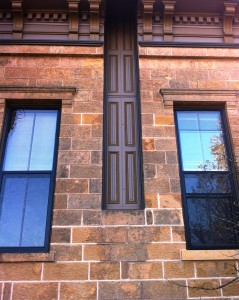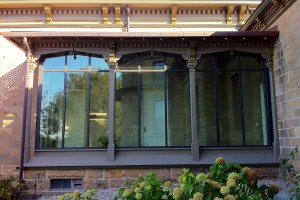I was in Madison, Wisconsin, for a conference last week. I took advantage of the beautiful autumn weather to pay a quick afternoon visit to the Washburn Observatory on the University of Wisconsin campus. The observatory stands on top of Observatory Hill, at a point from which visitors have a fantastic view of Lake Mendota. Unfortunately, I only had my iPhone camera with me, so I couldn’t do the building justice in terms architectural documentation (and didn’t even try to make an appointment to view the instruments inside, where I was sure my camera would disappoint me), but did manage to capture a few interesting exterior details.
The observatory exists because of the generosity of former Wisconsin governor Cadwallader C. Washburn, who donated the money and selected the site for the building. Washburn was apparently motivated by a desire to show up those hotshots at Harvard College Observatory—he agreed to fund the project, but required that the instrument to be acquired for the observatory be larger than the 15″ refractor then in use at Harvard. Work on the observatory began in May 1878 under the supervision of architect David R. Jones (also selected by Washburn), and Alvan Clark and Sons built a 15.6″ refractor for the new observatory, temporarily putting Harvard in its place.[1]
What stands now on Observatory Hill bears a close resemblance to the original observatory. Even before the formal dedication in 1882, the building had been expanded beyond the original program, which had called only for a domed space for the telescope, with two flanking wings to house a meridian circle and other equipment.
The first director of the observatory, James Craig Watson, requested that calculating rooms and living quarters be added; the addition, built to the east and connected to the first building by a short passageway, was completed in 1881. Watson also provided funds for a second observatory, intending to train students with the telescope in that space rather than with the refractor under the main dome.
In one of those tragic twists of fate, both Washburn and Watson died before the observatory’s dedication (Washburn in 1882 , Watson in 1880). Edward S. Holden (b. 1846-d. 1914) transferred from the U.S. Naval Observatory to Wisconsin, where he served as director of the observatory from 1881-1885.[2] By the end of Holden’s tenure, the observatory’s architecture was largely set in place; only a few small changes took place over the next 50 years or so. For instance, the porch on the east wing was enclosed in the 1920s.
A wrought-iron balcony was added to the main dome (only accessible from the telescope room) at some later date, and the interior of the building was reconfigured at various times to accommodate changing needs for office and classroom space.
”] Like most observatories of its age, its instrumentation is useful for lessons in the history of astronomy and public outreach. The real astronomical research at University of Wisconsin has moved on to other spaces and other pursuits. The building was completely renovated in 2008-09 so that it could be given over to the UW College of Letters and Sciences Honors Program. Public viewing sessions with the 15.6″ refractor are still held every other Wednesday (or so); otherwise, anyone is free to walk around and enjoy the observatory’s exterior at any time of the day.
Like most observatories of its age, its instrumentation is useful for lessons in the history of astronomy and public outreach. The real astronomical research at University of Wisconsin has moved on to other spaces and other pursuits. The building was completely renovated in 2008-09 so that it could be given over to the UW College of Letters and Sciences Honors Program. Public viewing sessions with the 15.6″ refractor are still held every other Wednesday (or so); otherwise, anyone is free to walk around and enjoy the observatory’s exterior at any time of the day.
______________
[1] This post relies upon information included in the the Feasibility Study for Washburn Observatory conducted by Isthmus Architecture, Inc. in April 2004.
[2] Holden left Wisconsin in 1885 to become the president of the University of California. In 1888, he became the first director of Lick Observatory.



